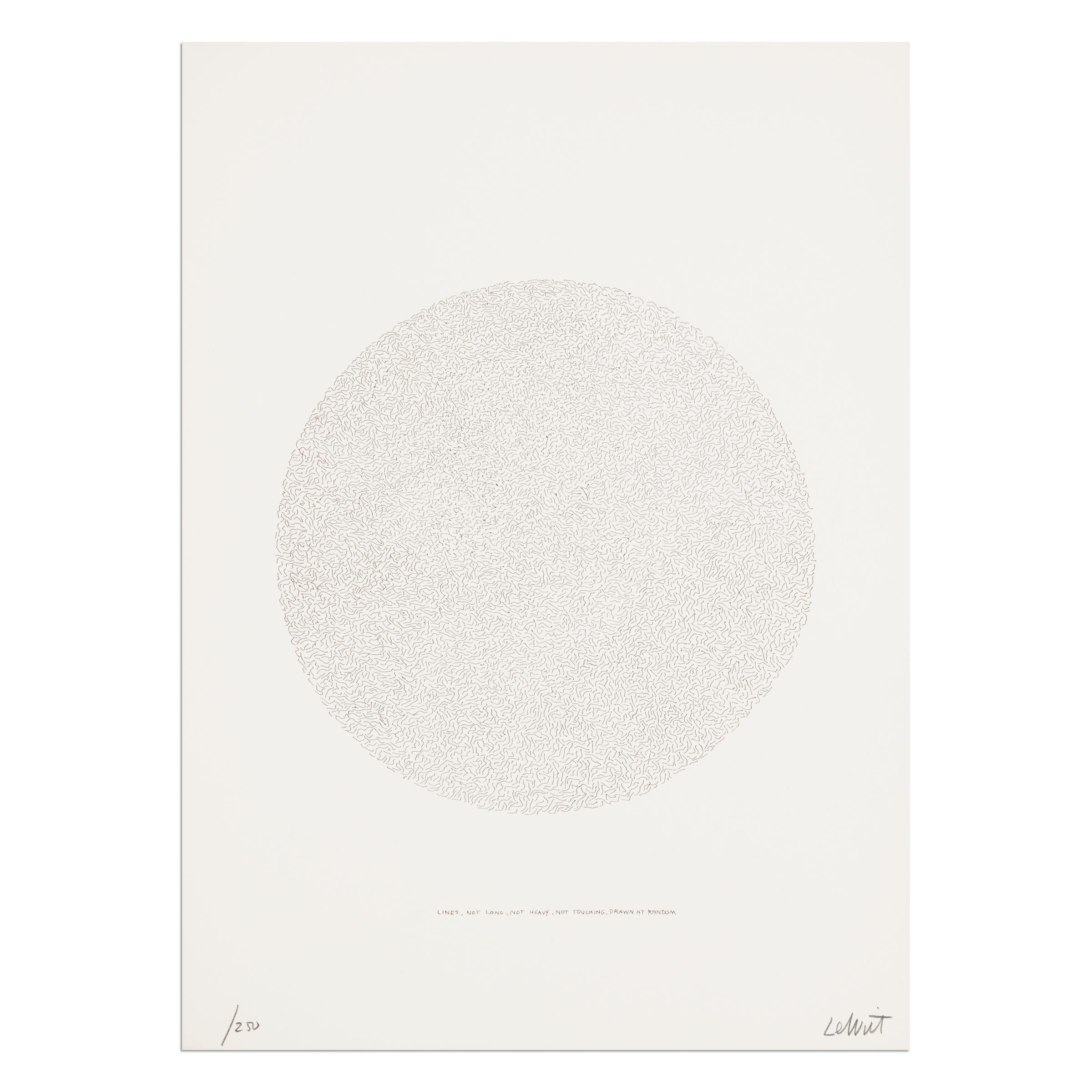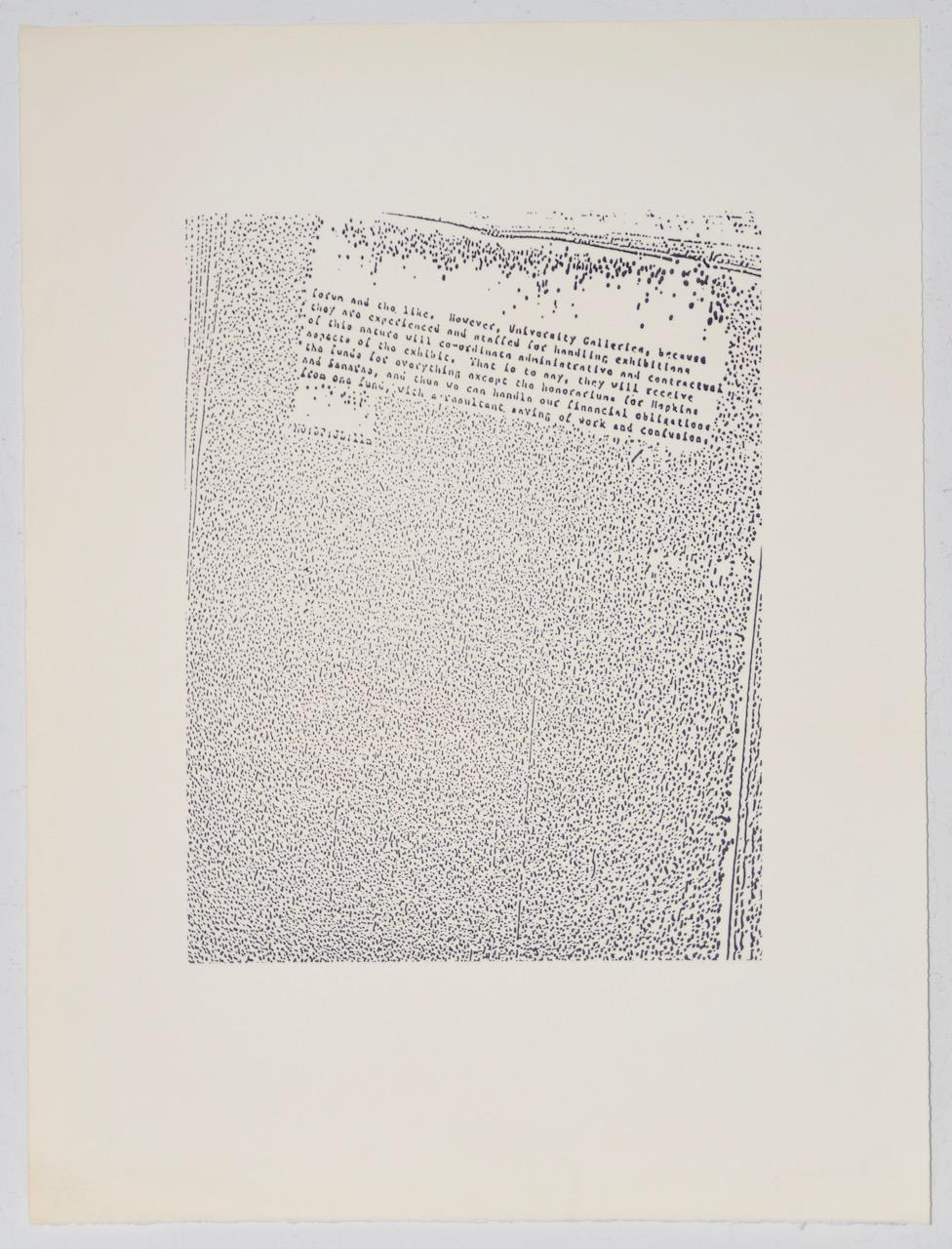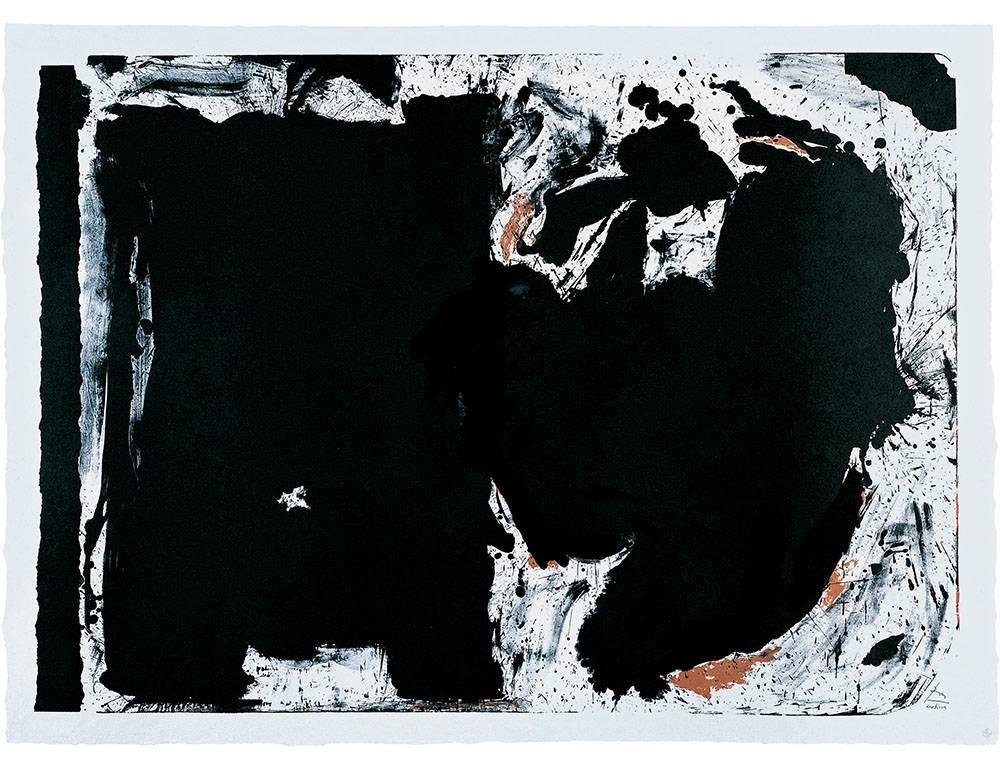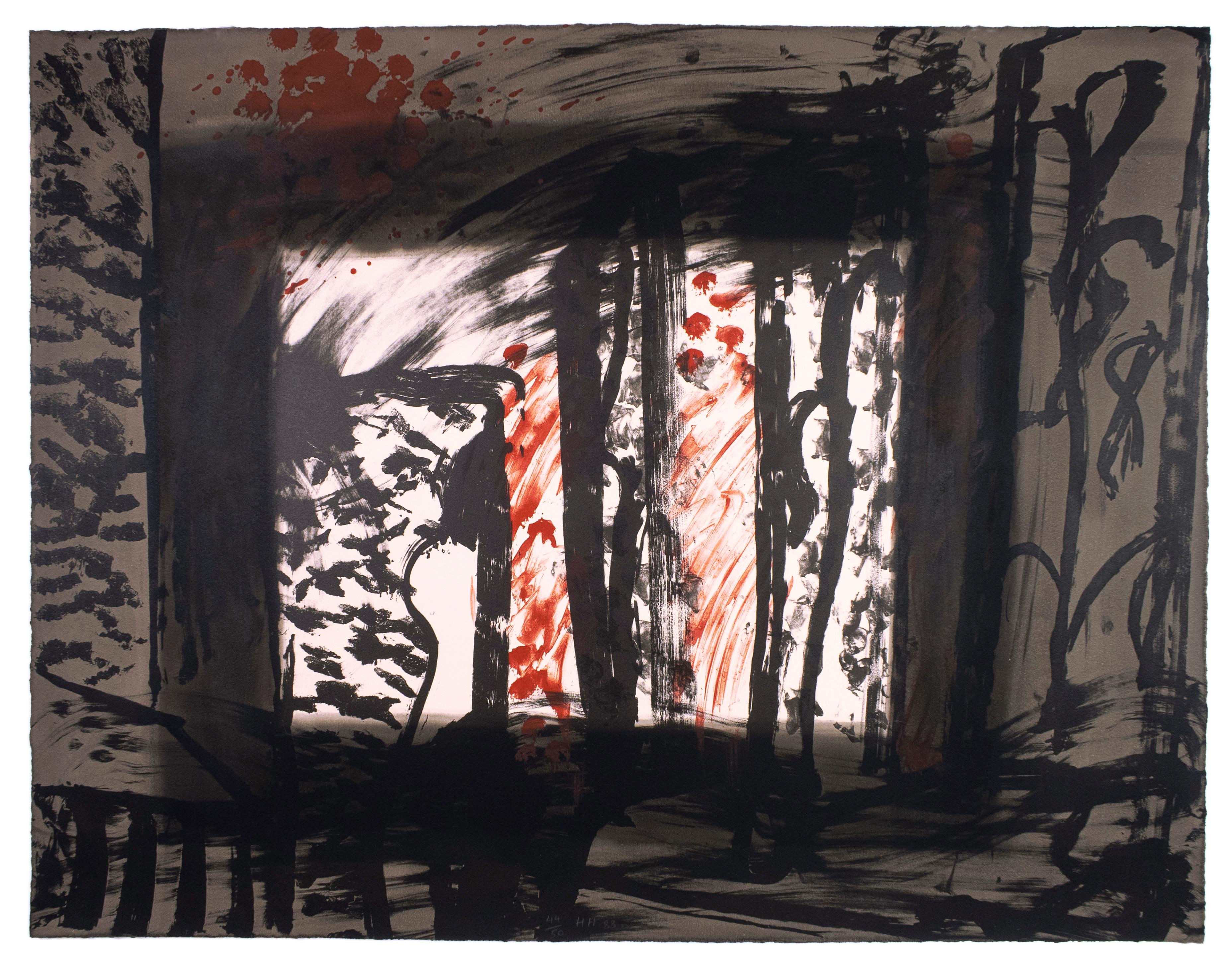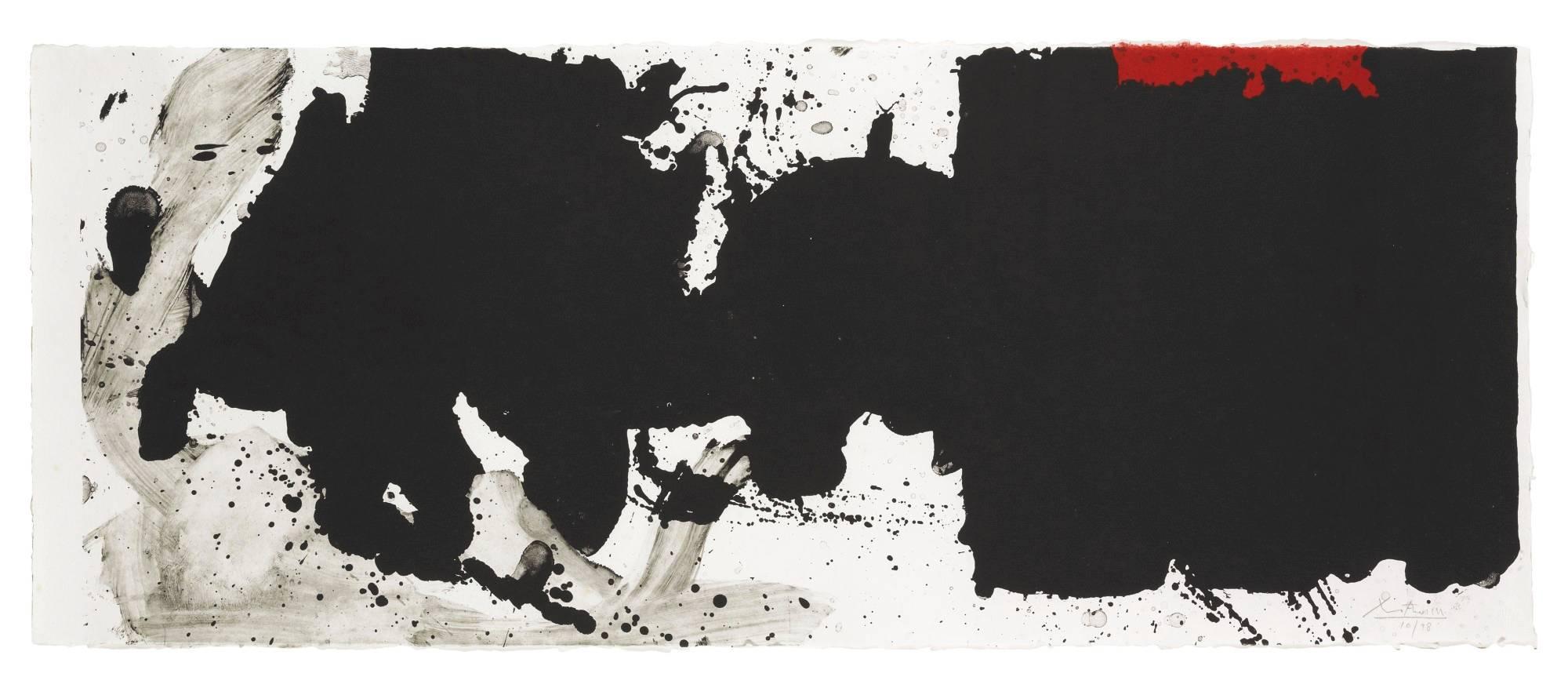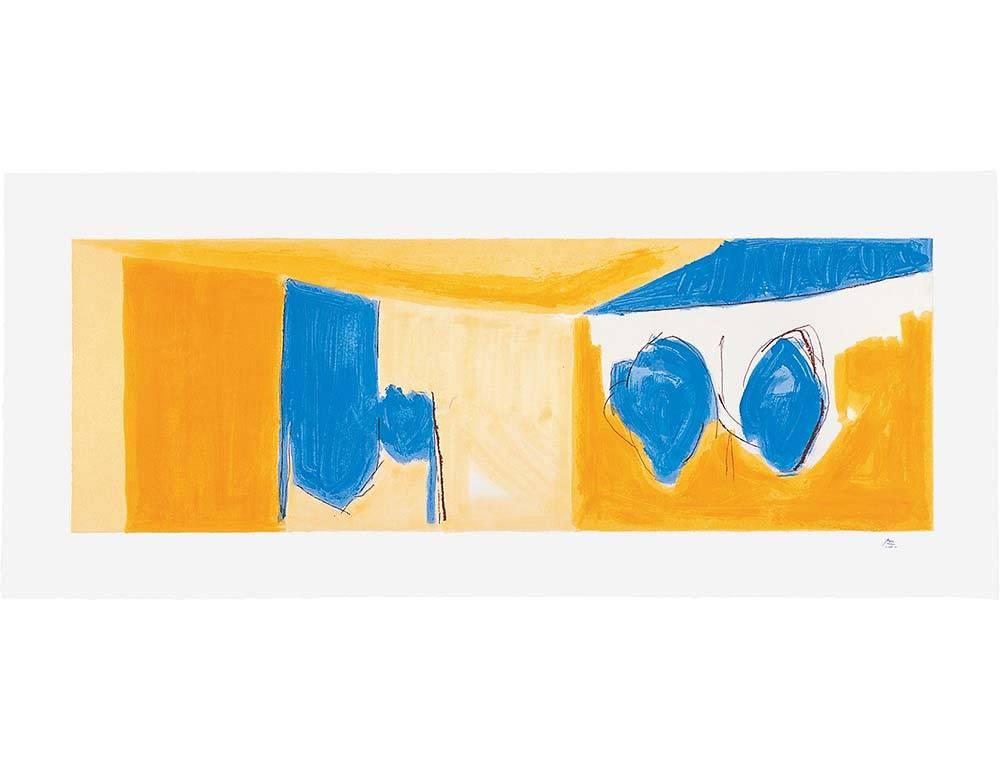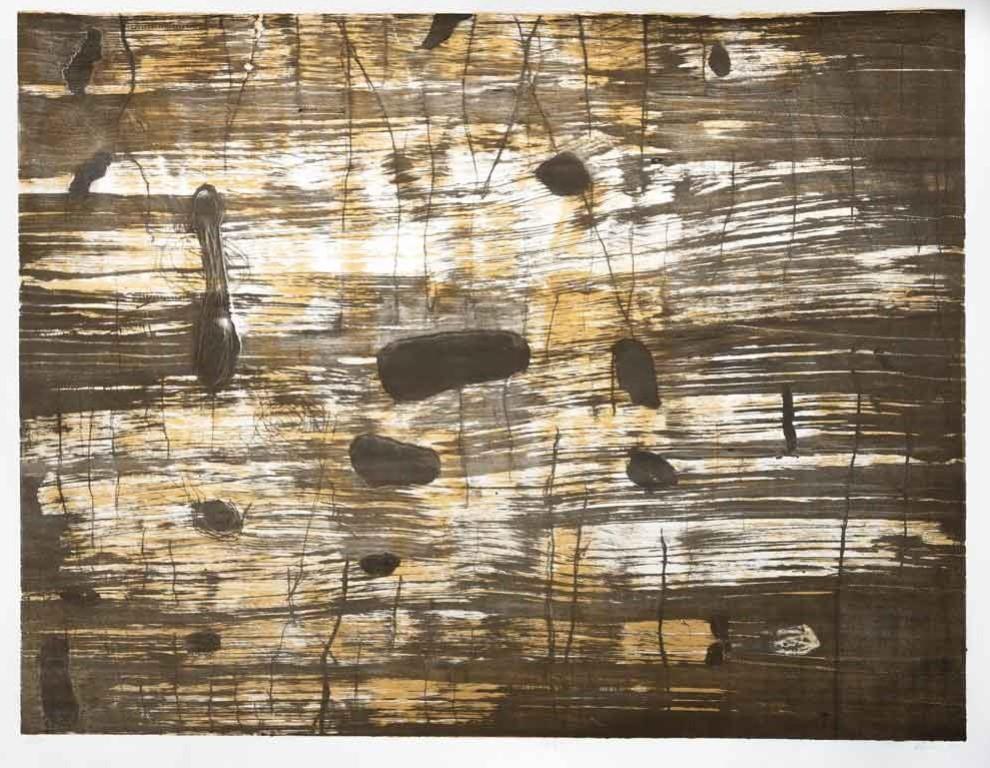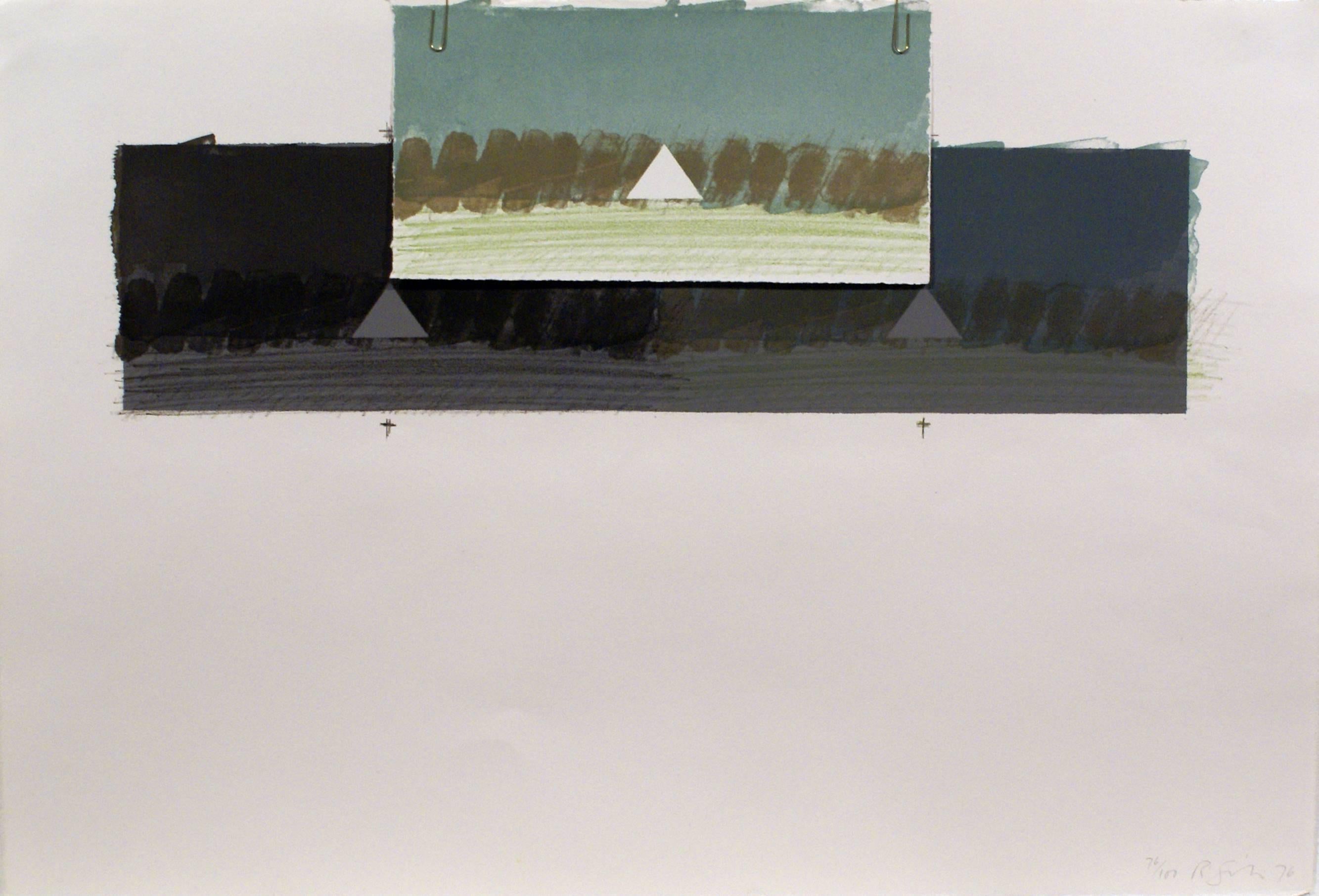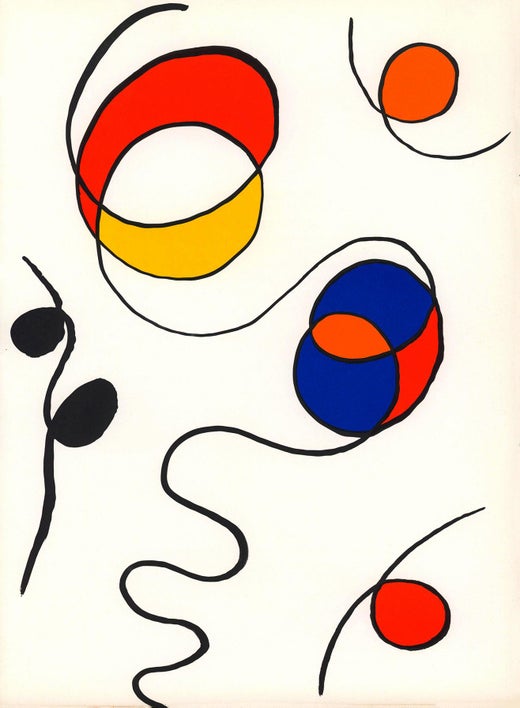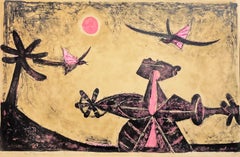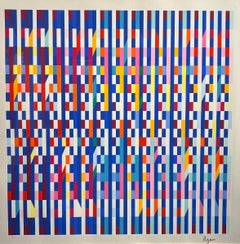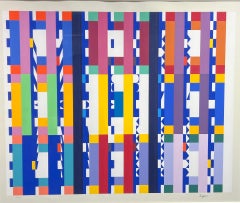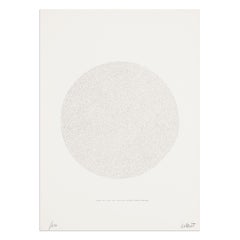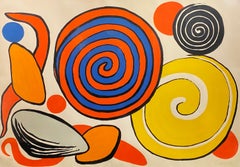
Red and Blue Spirals
View Similar Items
Alexander CalderRed and Blue Spirals
About the Item
- Creator:Alexander Calder (1898 - 1976, American)
- Dimensions:Height: 26 in (66.04 cm)Width: 37 in (93.98 cm)
- Medium:
- Movement & Style:
- Period:
- Condition:
- Gallery Location:Missouri, MO
- Reference Number:1stDibs: LU747314223962
Alexander Calder
The American sculptor Alexander Calder is known as the father of the mobile, a moving artwork composed of delicately balanced sculptural forms suspended from the ceiling.
Because Calder's parents, both artists themselves, did not want him to suffer the hardships of trying to make a living in art, they encouraged the young Calder to study mechanical engineering at the Stevens Institute of Technology, in Hoboken, New Jersey. He worked a number of jobs, including as a hydraulic engineer and draftsman for the New York Edison Company, before deciding to pursue an artistic career. He never abandoned his engineering background, however, applying his understanding of gears and moving parts in all his artworks, from mechanical toys like the Cirque Calder (1931) and his revered prints to his free-standing abstract sculptures, called stabiles.
In 1926, Calder moved to Paris and established a studio in the Montparnasse quarter. He began creating the many parts of his famous miniature circus from found materials, such as wire, string, cloth, rubber and cork. Designed to be transportable, Cirque grew to fill five suitcases over the years. Always interested in putting forms in motion, Calder also pioneered a new art form called wire sculptures, which he described as “drawings in space.” Like his famous mobiles, the wire sculptures were suspended so that they turned with any movement of the air, presenting different forms when viewed from different angles.
In the 1950s, Calder returned to his roots in mechanical engineering, creating monumental abstract sculptures that verged on the architectural. He worked from loose gestural drawings like this preparatory sketch for his Man Stabile, from 1966. Throughout his career, he also worked as a set designer for the theater, as well as an illustrator and printmaker, producing vibrant, whimsical drawings for books and journals.
Find original Alexander Calder art today on 1stDibs.
- Observador de PajarosBy Rufino TamayoLocated in Missouri, MO"Observador de Pajaros" 1950 By. Rufino Tamayo (Mexican, 1899-1991) Edition 83/210 Lower Right Signed Lower Left Unframed: 15.5" x 22.5" Framed: 21.75" x 28.25" Rufino Tamayo (August 26, 1899- June 24, 1991) A native of Oaxaca in Southern Mexico, Rufino Tamayo's father was a shoemaker, and his mother a seamstress. Some accounts state that he was descended from Zapotec Indians, but he was actually 'mestizo' - of mixed indigenous/European ancestry. (Santa Barbara Museum of Art). He began painting at age 11. Orphaned at the age of 12, Tamayo moved to Mexico City, where he was raised by his maternal aunt who owned a wholesale fruit business. In 1917, he entered the San Carlos Academy of Fine Arts, but left soon after to pursue independent study. Four years later, Tamayo was appointed the head designer of the department of ethnographic drawings at the National Museum of Archaeology in Mexico City. There he was surrounded by pre-Colombian objects, an aesthetic inspiration that would play a pivotal role in his life. In his own work, Tamayo integrated the forms and tones of pre-Columbian ceramics into his early still lives and portraits of Mexican men and women. In the early 1920s he also taught art classes in Mexico City's public schools. Despite his involvement in Mexican history, he did not subscribe to the idea of art as nationalistic propaganda. Modern Mexican art at that time was dominated by 'The Three Great Ones' : Diego Rivera, Jose Clemente Orozco, and David Alfaro Siqueros, but Tamayo began to be noted as someone 'new' and different' for his blending of the aesthetics of post Revolutionary Mexico with the vanguard artists of Europe and the United States. After the Mexican Revolution, he focused on creating his own identity in his work, expressing what he thought was the traditional Mexico, and refusing to follow the political trends of his contemporary artists. This caused some to see him as a 'traitor' to the political cause, and he felt it difficult to freely express himself in his art. As a result, he decided to leave Mexico in 1926 and move to New York, along with his friend, the composer Carlos Chavez. The first exhibition of Tamayo's work in the United States was held at the Weyhe Gallery, New York, in that same year. The show was successful, and Tamayo was praised for his 'authentic' status as a Mexican of 'indigenous heritage', and for his internationally appealing Modernist aesthetic. (Santa Barbara Museum of Art). Throughout the late thirties and early forties New York's Valentine Gallery gave him shows. For nine years, beginning in 1938, he taught at the Dalton School in New York. In 1929, some health problems led him to return to Mexico for treatment. While there he took a series of teaching jobs. During this period he became romantically involved with the artist Maria...Category
20th Century Abstract Abstract Prints
MaterialsLithograph
Price Upon Request - Blue Rings (Abstract Composition)By Yaacov AgamLocated in Missouri, MOBlue Rings (Abstract Composition), Serigraph By Yaacov Agam (Israeli, b. 1928) Signed Lower Right Edition 8/270 Lower Left Unframed: 21" x 21.5" Framed: 31" ...Category
20th Century Abstract Abstract Prints
MaterialsLithograph
Price Upon Request - CurtainBy Yaacov AgamLocated in Missouri, MOCurtain By. Yaacov Agam (Israeli, b. 1928) Signed Lower Right Edition 221/227 Unframed: 18" x 22.5" Framed: 30.5" x 34.5" Yaacov Agam is one of the pioneer creators of the kinetic movement in art as well as its most outstanding contemporary representative. Agam was born in 1928 a son of a Rabbi of Rishon LeZion (Israel), who devoted his life to the study of Jewish religious matters and wrote books. Agam considers himself somehow as a visual continuation of his father's quest for spirituality. He studied at the Bezalel Academy of Art in Jerusalem, and in Switzerland at the Eidgenossische Technische Hochschule and the Zurich University. After arriving to Paris in 1951, Agam held his first one man exhibition with a great success in 1953 This exhibition consisted totally of kinetic, movable and transformable paintings, which actually was the first one-man show in art history exclusively devoted to kinetic art. A passionate experimenter, Agam deals with such problems as the 4th dimension, simultaneity and time in the visual, plastic arts, and has extended his experiments to application in the fields of literature, music and art theory. His works express a concept that breaks away with the established way of expressing reality in limited, static way. In his works, he strives to demonstrate the principle of reality as a continuous "becoming" rather than static "graven image." His paintings Double Metamorphosis 11 in the Museum of Modern Art in New York and Transparent Rhythms 11 in the Hirshhorn Museum and Sculpture Garden of the Smithsonian Institution in Washington, D.C. give the best example of his polymorphic painting. His works are placed in many public places including Communication x 9 on the Michigan Avenue in Chicago (1983), Communication: Night and Day at the AT&T building in New York (1974), Super Lines Volumes at the Pare Floral in Paris (1971), and his murals Peace and Life arc installed at the Parliament of Europe in Strasbourg (1977). Agam has expressed the new concepts in monumental works as in his Jacob's Ladder, which forms the ceiling of the National Convention House in Jerusalem. He created a "floating museum", including all the artworks for public areas and cabins, for the Carnival Cruise Line's luxury cruise ship "Celebration" (1987). His fire-water fountain in Dizengoff Square in Tel Aviv (1986) streams water, fire, and music -elements of flux and life which cannot be static - as its colored elements rotate in this multidimensional monumental work. For the Elysee Palace in Paris, with the request of President Georges Pompidou Agam created in 1972 a whole environmental of the Salon with the walls covered with polymorphic murals of changing images a kinetic ceiling, moving transparent colored doors and a kinetic carpet on which he placed a sculpture. It embraces viewers: they are no longer looking at a framed, fixed scene, but rather arc moving within an artistic space which changes constantly according to their shifting position and point of view. Similar attempt was made for the concert hall, Forum Leverkusen in Germany in 1970. Agam created many environmental sculptures, including Hundred Gates in the garden of the residence of the President of Israel in Jerusalem, 3 x 3 Interplay installed at the Julliard School of Music at the Lincoln Center and Wings of the Heart at J. F. Kennedy airport in New York. In 1984, he made a sculpture Beating Heart for the Hadassah Hospital in Jerusalem. In 1988, he created a transparent torah ark...Category
20th Century Abstract Abstract Prints
MaterialsLithograph
Price Upon Request - EmergingBy Yaacov AgamLocated in Missouri, MOEmerging, 1985 By. Yaacov Agam ( Israeli, b. 1928) Color Serigraph Signed Lower Right Edition 1/12 Lower Left Unframed: 25" x 31" Framed: 34" x 43" Yaacov Agam is one of the pioneer creators of the kinetic movement in art as well as its most outstanding contemporary representative. Agam was born in 1928 a son of a Rabbi of Rishon LeZion (Israel), who devoted his life to the study of Jewish religious matters and wrote books. Agam considers himself somehow as a visual continuation of his father's quest for spirituality. He studied at the Bezalel Academy of Art in Jerusalem, and in Switzerland at the Eidgenossische Technische Hochschule and the Zurich University. After arriving to Paris in 1951, Agam held his first one man exhibition with a great success in 1953 This exhibition consisted totally of kinetic, movable and transformable paintings, which actually was the first one-man show in art history exclusively devoted to kinetic art. A passionate experimenter, Agam deals with such problems as the 4th dimension, simultaneity and time in the visual, plastic arts, and has extended his experiments to application in the fields of literature, music and art theory. His works express a concept that breaks away with the established way of expressing reality in limited, static way. In his works, he strives to demonstrate the principle of reality as a continuous "becoming" rather than static "graven image." His paintings Double Metamorphosis 11 in the Museum of Modern Art in New York and Transparent Rhythms 11 in the Hirshhorn Museum and Sculpture Garden of the Smithsonian Institution in Washington, D.C. give the best example of his polymorphic painting. His works are placed in many public places including Communication x 9 on the Michigan Avenue in Chicago (1983), Communication: Night and Day at the AT&T building in New York (1974), Super Lines Volumes at the Pare Floral in Paris (1971), and his murals Peace and Life arc installed at the Parliament of Europe in Strasbourg (1977). Agam has expressed the new concepts in monumental works as in his Jacob's Ladder, which forms the ceiling of the National Convention House in Jerusalem. He created a "floating museum", including all the artworks for public areas and cabins, for the Carnival Cruise Line's luxury cruise ship "Celebration" (1987). His fire-water fountain in Dizengoff Square in Tel Aviv (1986) streams water, fire, and music -elements of flux and life which cannot be static - as its colored elements rotate in this multidimensional monumental work. For the Elysee Palace in Paris, with the request of President Georges Pompidou Agam created in 1972 a whole environmental of the Salon with the walls covered with polymorphic murals of changing images a kinetic ceiling, moving transparent colored doors and a kinetic carpet on which he placed a sculpture. It embraces viewers: they are no longer looking at a framed, fixed scene, but rather arc moving within an artistic space which changes constantly according to their shifting position and point of view. Similar attempt was made for the concert hall, Forum Leverkusen in Germany in 1970. Agam created many environmental sculptures, including Hundred Gates in the garden of the residence of the President of Israel in Jerusalem, 3 x 3 Interplay installed at the Julliard School of Music at the Lincoln Center and Wings of the Heart at J. F. Kennedy airport in New York. In 1984, he made a sculpture Beating Heart for the Hadassah Hospital in Jerusalem. In 1988, he created a transparent torah ark...Category
20th Century Abstract Abstract Prints
MaterialsLithograph
Price Upon Request - SpectrumBy Yaacov AgamLocated in Missouri, MOSpectrum By. Yaacov Agam (Israeli, b. 1928) Signed Lower Right Edition 158/180 Lower Left Unframed: 27" x 33.5" Framed: 36.5" x 43" Yaacov Agam is one of the pioneer creators of the kinetic movement in art as well as its most outstanding contemporary representative. Agam was born in 1928 a son of a Rabbi of Rishon LeZion (Israel), who devoted his life to the study of Jewish religious matters and wrote books. Agam considers himself somehow as a visual continuation of his father's quest for spirituality. He studied at the Bezalel Academy of Art in Jerusalem, and in Switzerland at the Eidgenossische Technische Hochschule and the Zurich University. After arriving to Paris in 1951, Agam held his first one man exhibition with a great success in 1953 This exhibition consisted totally of kinetic, movable and transformable paintings, which actually was the first one-man show in art history exclusively devoted to kinetic art. A passionate experimenter, Agam deals with such problems as the 4th dimension, simultaneity and time in the visual, plastic arts, and has extended his experiments to application in the fields of literature, music and art theory. His works express a concept that breaks away with the established way of expressing reality in limited, static way. In his works, he strives to demonstrate the principle of reality as a continuous "becoming" rather than static "graven image." His paintings Double Metamorphosis 11 in the Museum of Modern Art in New York and Transparent Rhythms 11 in the Hirshhorn Museum and Sculpture Garden of the Smithsonian Institution in Washington, D.C. give the best example of his polymorphic painting. His works are placed in many public places including Communication x 9 on the Michigan Avenue in Chicago (1983), Communication: Night and Day at the AT&T building in New York (1974), Super Lines Volumes at the Pare Floral in Paris (1971), and his murals Peace and Life arc installed at the Parliament of Europe in Strasbourg (1977). Agam has expressed the new concepts in monumental works as in his Jacob's Ladder, which forms the ceiling of the National Convention House in Jerusalem. He created a "floating museum", including all the artworks for public areas and cabins, for the Carnival Cruise Line's luxury cruise ship "Celebration" (1987). His fire-water fountain in Dizengoff Square in Tel Aviv (1986) streams water, fire, and music -elements of flux and life which cannot be static - as its colored elements rotate in this multidimensional monumental work. For the Elysee Palace in Paris, with the request of President Georges Pompidou Agam created in 1972 a whole environmental of the Salon with the walls covered with polymorphic murals of changing images a kinetic ceiling, moving transparent colored doors and a kinetic carpet on which he placed a sculpture. It embraces viewers: they are no longer looking at a framed, fixed scene, but rather arc moving within an artistic space which changes constantly according to their shifting position and point of view. Similar attempt was made for the concert hall, Forum Leverkusen in Germany in 1970. Agam created many environmental sculptures, including Hundred Gates in the garden of the residence of the President of Israel in Jerusalem, 3 x 3 Interplay installed at the Julliard School of Music at the Lincoln Center and Wings of the Heart at J. F. Kennedy airport in New York. In 1984, he made a sculpture Beating Heart for the Hadassah Hospital in Jerusalem. In 1988, he created a transparent torah ark...Category
20th Century Abstract Abstract Prints
MaterialsLithograph
Price Upon Request - Untitled, (Serigraph)By Yaacov AgamLocated in Missouri, MOUntitled (Serigraph) By Yaacov Agam (Israeli, b. 1928) Signed Lower Right Edition 56/180 Lower Left Unframed: 20" x 8" Framed: 26.25" x 14" Yaacov Agam is one of the pioneer creators of the kinetic movement in art as well as its most outstanding contemporary representative. Agam was born in 1928 a son of a Rabbi of Rishon LeZion (Israel), who devoted his life to the study of Jewish religious matters and wrote books. Agam considers himself somehow as a visual continuation of his father's quest for spirituality. He studied at the Bezalel Academy of Art in Jerusalem, and in Switzerland at the Eidgenossische Technische Hochschule and the Zurich University. After arriving to Paris in 1951, Agam held his first one man exhibition with a great success in 1953 This exhibition consisted totally of kinetic, movable and transformable paintings, which actually was the first one-man show in art history exclusively devoted to kinetic art. A passionate experimenter, Agam deals with such problems as the 4th dimension, simultaneity and time in the visual, plastic arts, and has extended his experiments to application in the fields of literature, music and art theory. His works express a concept that breaks away with the established way of expressing reality in limited, static way. In his works, he strives to demonstrate the principle of reality as a continuous "becoming" rather than static "graven image." His paintings Double Metamorphosis 11 in the Museum of Modern Art in New York and Transparent Rhythms 11 in the Hirshhorn Museum and Sculpture Garden of the Smithsonian Institution in Washington, D.C. give the best example of his polymorphic painting. His works are placed in many public places including Communication x 9 on the Michigan Avenue in Chicago (1983), Communication: Night and Day at the AT&T building in New York (1974), Super Lines Volumes at the Pare Floral in Paris (1971), and his murals Peace and Life arc installed at the Parliament of Europe in Strasbourg (1977). Agam has expressed the new concepts in monumental works as in his Jacob's Ladder, which forms the ceiling of the National Convention House in Jerusalem. He created a "floating museum", including all the artworks for public areas and cabins, for the Carnival Cruise Line's luxury cruise ship "Celebration" (1987). His fire-water fountain in Dizengoff Square in Tel Aviv (1986) streams water, fire, and music -elements of flux and life which cannot be static - as its colored elements rotate in this multidimensional monumental work. For the Elysee Palace in Paris, with the request of President Georges Pompidou Agam created in 1972 a whole environmental of the Salon with the walls covered with polymorphic murals of changing images a kinetic ceiling...Category
20th Century Abstract Abstract Prints
MaterialsLithograph
Price Upon Request
- Sol LeWitt, Lines, Not Long, Not Heavy, Not Touching, Drawn at Random (Circle)By Sol LeWittLocated in Hamburg, DESol LeWitt (American, 1928-2007) Lines, Not Long, Not Heavy, Not Touching, Drawn at Random (Circle), 1970 Medium: Lithograph on wove paper Dimensions: 44.5 × 32.1 cm (17.5 × 12.6 in)...Category
20th Century Abstract Abstract Prints
MaterialsLithograph
- Geneviève Claisse - Kinetic Composition - Original Signed LithographBy Geneviève ClaisseLocated in Collonge Bellerive, Geneve, CHGeneviève Claisse - Kinetic Composition - Original Signed Lithograph Publisher Stamp Edition: EA Geneviève CLAISSE, born in 1935 in France, a relative to Auguste Herbin. She is recognized today as one of the most important geometrical abstract French artist of the 1970s. Her approach to painting was influenced by reading Art d’Aujourd’hui, Tribune of Geometrical Abstraction. 1958 First solo exhibits in the Galerie Caille in Cambrai and Galerie Hybler in Paris. 1961 First exhibit in the Galerie Denise René in Paris where she regularly exhibited in the following years. 1965 + Focused work on color (Cercles, ADN) 1967 Museum of Fine Arts of La Chaux-de-Fonds. Biennale of Paris. 1968 “Art...Category
2010s Abstract Geometric Abstract Prints
MaterialsLithograph
- John Link (American, b.1942) "Untitled" Limited Edition Lithograph c.1973By John LinkLocated in San Francisco, CAJohn Link (American, b.1942) "Untitled" Limited Edition Lithograph c.1973 Rare mid 20th century lithograph by noted American artist John Link. The lithograph shows an area of illegible text surrounded by a block of black dots. Art dimensions 16" x 20". The hand made paper measures 24" x 32". Pencil signed and numbered by the artist. Number 32 out of 60. Very good condition. Comes unframed. John Link studied at the University of Oklahoma. Exhibitions include: Joslyn Biennale; Oklahoma Art...Category
Mid-20th Century Abstract Expressionist Abstract Prints
MaterialsLithograph
- Lament for LorcaBy Robert MotherwellLocated in London, GBLithograph on white Tyler Graphics Ltd. (TGL) handmade paper 44x61 in (111.8x154.9cm) Edition of 52Category
1980s Abstract Expressionist Abstract Prints
MaterialsColor, Lithograph
- Seeing Voice Welsh HeartBy Paul JenkinsLocated in New York, NYA very good impression of this color lithograph on Rives BFK. Signed and numbered 30/40 in pencil. Printed by Mourlot, Paris. Published by Galerie Karl Flinker, Paris. From the same-...Category
1960s Abstract Expressionist Abstract Prints
MaterialsColor, Lithograph
- Sand Howard Hodgkin abstract sepia black and white earth tone painting printBy Howard HodgkinLocated in New York, NYAbstract, large scale earth toned red, black, taupe and grey scene with dynamic lines, shapes and hand painted brushstroke texture. This dramatic Howard Hodgkin work is ideal for dis...Category
1980s Abstract Abstract Prints
MaterialsWatercolor, Lithograph
Recently Viewed
View AllRead More
Renowned for His Mobiles, Alexander Calder Was Also Adept at Crafting Modernist Jewelry
There are no sparkling gemstones on this necklace, but its value far exceeds the cost of its materials.
10 Must-Visit American Public Sculptures
Get your dose of Vitamin D while surveying works by the likes of Alexander Calder, Keith Haring and Pablo Picasso.
